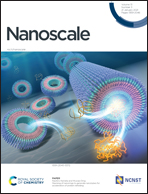Vapor phase polymerized conducting polymer/MXene textiles for wearable electronics†
Abstract
Multifunctional electronic textiles hold great potential applications in the wearable electronics field. However, it remains challenging to seamlessly integrate the multiple functions on the textile substrates without sacrificing their intrinsic properties. Herein, we report a novel and facile vapor phase polymerization (VPP) and spray-coating strategy towards the construction of a laminated film containing a PEDOT film and Ti3C2Tx MXene sheets on the fiber surface. The fabricated PEDOT/MXene decorated cotton fabrics are integrated with excellent electrochemical performance, joule heating performance, good electromagnetic interference (EMI) shielding, and strain sensing performance. The resultant multifunctional textiles have a low sheet resistance of 3.6 Ω sq−1, and the assembled all-solid-state fabric supercapacitors exhibit an ultrahigh specific capacitance of 1000.2 mF cm−2, which exceeds the state-of-the-art MXene-based fabric supercapacitors. In addition, the PEDOT/MXene modified fabrics exhibit an exceptional joule heating performance of 193.1 °C at the applied voltage of 12 V, high EMI shielding effectiveness of 36.62 dB, and high sensitivity as strain sensors for human motion detection. This work provides a novel strategy for the structure design of multifunctional textiles and will lay the foundation for the development of multifunctional wearable electronics.



 Please wait while we load your content...
Please wait while we load your content...